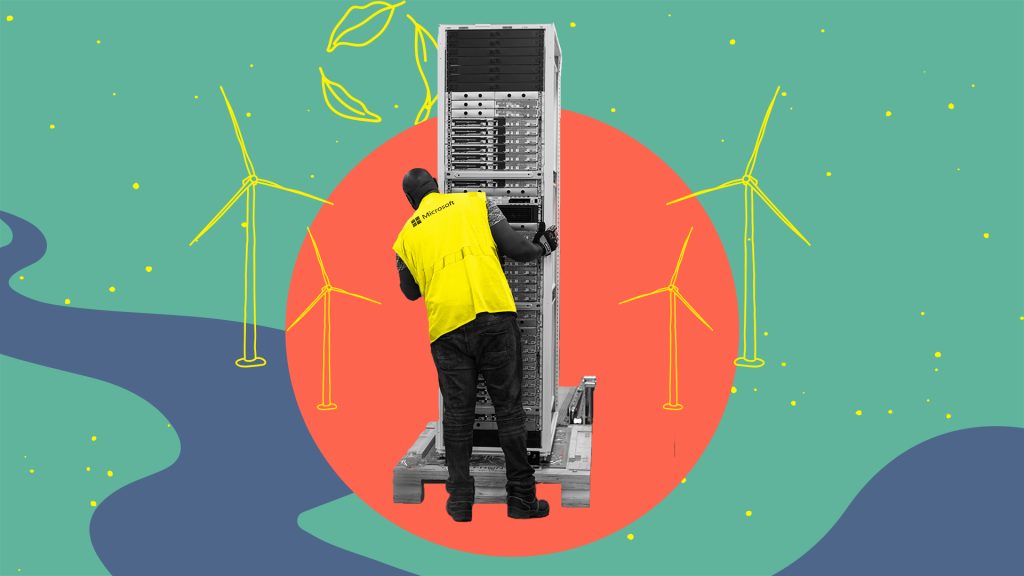’Critical to our modern society’: How datacenters power everyday necessities
In Berlin, a mother chats with her child’s doctor via a computer screen. In a Paris shop, the grocery shelves are stocked and more supplies are on the way. In Amsterdam, a student makes an online rent payment. In Romania, an ambulance is dispatched to a car accident.
All those moments – along with countless conveniences that pack daily life – nowadays happen with the help of datacenters. Purposely nondescript, these warehouses contain tens of thousands of interconnected computer servers plus the equipment needed to ensure the servers are always running, always available.

Simply put, they are the physical infrastructure behind cloud computing. And across Europe, Microsoft datacenters are operating around the clock to support a wide spectrum of critical services, from the life-saving work of doctors and first responders to essential services like groceries and online banking. At the same time, datacenters also empower everyday necessities like food deliveries, remote work and video calls to family.
As Europeans brace for the possibility of a wintertime energy crisis, market researchers and energy consultants are calling datacenters critical enablers of modern society – including how they foster hybrid work schedules that reduce travel and allow office buildings to use less heat and electricity.
Despite the role datacenters play in so many aspects of people’s lives, most people don’t give them a second thought.
“Without datacenter infrastructure, which is the invisible infrastructure, will you still be able to do the things you need for working, resting and playing? Unless you’re off grid, the answer is no, you’re not going to be able to do any of those things,” says Rahiel Nasir, an associate research director at the market research firm IDC. He is based in the U.K.
“They are critical to our modern society,” adds Nasir, a member of IDC’s European cloud and cloud data management research programs.
Echoing those words, energy advisers Baringa labeled datacenters as “essential for modern society” – the top finding of a July report published by the U.K.-based consultancy.
From health care to grocery shopping, from online schools to online banking, it’s difficult to think of many corners of life that aren’t dependent on cloud services hosted in datacenters. Microsoft Azure and Microsoft Teams are products that rely on datacenters.

In medicine, hundreds of hospitals and clinics in Europe rely on Azure’s cloud capabilities to track patient records, schedule surgeries and engage with patients via telehealth systems. A German software company created an Azure-based solution that has helped more than 600 European health care facilities manage the work schedules of doctors, nurses and other staff.
A hospital in the Czech Republic uses Azure IoT to help monitor medication storage. In Poland, a surgeon uses augmented reality to precisely perform a procedure. And Azure hosts the public health records and the robotic medicine dispensing system for a hospital in Malta.
For urgent medical matters, Microsoft datacenters support emergency dispatch services across Europe, including 112-call systems and the mapping platforms that help route emergency vehicles to people in need and to the nearest hospitals.
In the world of money, some European financial services run their risk assessment programs in Azure, helping them make smarter decisions about where and how to invest. The cloud also enables financial trading systems, a core driver of economic markets.
In the stores, some European retailers rely on Microsoft Teams and its cloud-based collaboration functions to communicate with employees in the aisles or checkout lanes. At the back end, datacenters allow retail managers to track stock.
And to keep the lights on in those stores as well as in thousands of other businesses, hospitals and private homes, European utility providers trust datacenters to carry the critical workloads that help them manage electrical grids.
“Just looking across that list of industries and all the enablement they provide, datacenters are critical,” says Corey Sanders, corporate vice president of Microsoft cloud for industry and global expansion.
“Across almost every industry – manufacturing, transportation, even hospitality – there is some aspect of dependency, whether it be legacy services running in the cloud or modern digital transformation capabilities that have been invented in the cloud,” Sanders says.
The ability to ensure the cloud meets Europe’s needs and serves Europe’s values is also a core part of a new set of European Cloud Principles Microsoft Vice Chair and President Brad Smith announced in May of this year, after discussions with a number of European partners.
In fact, most European companies now rely on hybrid cloud or external data services or have fully migrated to the cloud, according to Ewa Zborowska, an IDC research director based in Poland, citing IDC research.
What’s more, IDC predicts that by 2026, organizations that successfully adopt a data-led approach will generate more than 25% of their revenue from digital products, services or experiences. That was the top forecast in a recent report titled “IDC FutureScape: Worldwide Future of Digital Innovation 2022 Predictions.”
“It really is difficult to imagine today a company operating and relying on just what they have in their server room,” Zborowska says. “(Datacenters are) critical on a country level, a society level, but also critical if you look from the perspective of individual organizations.”

And for consumers themselves, the modern world would be far more time-consuming and arduous without the conveniences of online purchases and fully stocked stores. This spans products that provide the elements for family meals, cold-weather attire and the latest home repairs – in basic terms: food, clothing and shelter.
Most items that Europeans buy in stores or online are made by manufacturing plants and transported by shipping companies that rely on the cloud and European datacenters to underpin their operations, Sanders says.
“It’s fair to say many of the items in your house, on your shelves, in your medicine cabinet, in your garage, in your dresser are there right now because of datacenters,” Sanders says. “Every single product you could think of would basically struggle to get to your front door.”
Datacenters are also increasingly necessary to making businesses run efficiently.
When Ralph Haupter, president of Microsoft Europe, Middle East and Africa, speaks with European CEOs these days, one of the most pressing topics on their minds, he says, involves visualizing and gleaning insights from their supply chains.
Global supply chains produce massive and diverse data streams. Datacenters help companies make all that data accessible, manageable and insightful to organizations – and within organizations to different departments, Haupter says. Data insights mean value creation, which adds to the bottom line.
“Everything around supply and the information of goods – where they are, their capacity, their quality, their path to processing and production – is super crucial,” Haupter says.
That’s particularly vital in Germany where a new law, the Supply Chain Act, requires companies to monitor potential environmental and human rights risks across their supply chains.
“That is relevant for a lot of companies,” Haupter says. “In challenging times, businesses are focusing on how to improve the top line (their revenues) and on customer insights.

“They are focusing on the best ways to engage with the customer and increase the value proposition. They are doing that in more efficient ways by using the right channel to reach customers, by having the best price and best product to reach them. That is all data driven.”
Inside those same companies, many of the employees who carry out those tasks continue to do their jobs from remote locations. They rely on the cloud to communicate with their colleagues via video calls, virtual meetings, instant messages and file sharing. Those functions – the foundation of hybrid work – all run through datacenters.
“If you turn the lights out in your datacenter, you don’t have the services required to enable hybrid working, to enable anywhere working,” says IDC’s Nasir.
During the pandemic, hybrid work enabled millions of employees to shift their jobs to their homes or to other remote locations, allowing them to safely distance while helping their companies to thrive.
Many hybrid workers have continued to rely on Microsoft Teams to stay connected with colleagues and projects. At Microsoft, that required engineers to expand the Teams platform and services at unparalleled speed and scale, Sanders says.
“That scale was built on the back of the capacity of our datacenters,” Sanders says. “Without the backing of our datacenters, the hybrid story would never have been possible. And as we carry forward, hybrid work continues to be not only a reality, but actually a much-improved experience.”
Indeed, this is about the future of work.
Businesses and entire economies are increasingly driven by the benefits of artificial intelligence, machine learning and big data – the pillars of the fourth industrial revolution.
“All those are feeding into this future way of working,” Nasir says. “And that’s where the datacenter comes in because without that solid, reliable, resilient infrastructure in place, the whole thing just collapses. We’re back to where we were pre-pandemic and we’re all [going to] offices and we’re all commuting.”
Energy consultants Baringa found that the shift to working, meeting and studying online during the pandemic corresponded with a reduction in transportation emissions in Ireland of almost 2 million metric tons, according to the group’s July report.
They meet that moment by supporting wider sustainability efforts and by decarbonizing computing, Baringa stated in its report. Their research showed that cloud datacenters “can be 80% more energy efficient than traditional onsite services.”
What’s more, the Microsoft Cloud can be between 22 and 93 percent more energy efficient than traditional datacenters, depending on the specific comparison being made, according to a study Microsoft commissioned from WSP, a global consultancy with expertise in environmental and sustainability issues.
Datacenters provide energy efficiency because they centralize the long list of devices and technologies needed to generate computing power – from the network to the switches to all that data storage, Haupter says.

“There is no need for companies to have their own hardware facilities, their own datacenter heating or cooling, their own network, their own backup, their own technology infrastructure,” Haupter says.
Major cloud companies are also the leading buyers of renewable energy in Europe and the world, according to Baringa.
Microsoft is helping to add clean capacity to the grid by signing recent purchase agreements for more than 5 gigawatts of renewable energy around the world. Those agreements include more than 15 individual deals in Europe spanning Ireland, Denmark, Sweden and Spain.
Microsoft’s European datacenters are also taking other steps to be more sustainable. For example, the Microsoft datacenter region in Sweden harvests rainwater for use in the facility while the servers are cooled only with outside air.
The Nordic countries lead Europe when it comes to the percentage of companies that rely on that region’s datacenters, according to an IDC report published in February and titled “Global Cloud Datacenter Providers in Europe.”
In 2021, the average number of enterprises across the EU using cloud computing was 41%, but in Sweden and Finland that share was 75%, in Denmark it was 65% and in Norway it was 64%, IDC found.
“We have an energy crisis in Europe,” Nasir says. “We’re being threatened with brownouts and blackouts. Does that mean the datacenter providers are going to have to turn the lights off and all run on diesel generators? Hopefully not, because they have got energy efficient systems in place.”
Related:
- Hydrogen fuel cells could provide emission free backup power at datacenters
- Microsoft datacenter batteries to support growth of renewables on the power grid
- Microsoft tests hydrogen fuel cells for backup power at datacenters
- Microsoft’s virtual datacenter grounds ‘the cloud’ in reality
- Microsoft finds underwater datacenters are reliable, practical and use energy sustainably
- To cool datacenter servers, Microsoft turns to boiling liquid
Top image: An animated illustration (GIF) showing how Microsoft datacenters are operating around the clock to support the life-saving work of doctors and first responders while also empowering everyday necessities like food deliveries, remote work and video calls to family.
